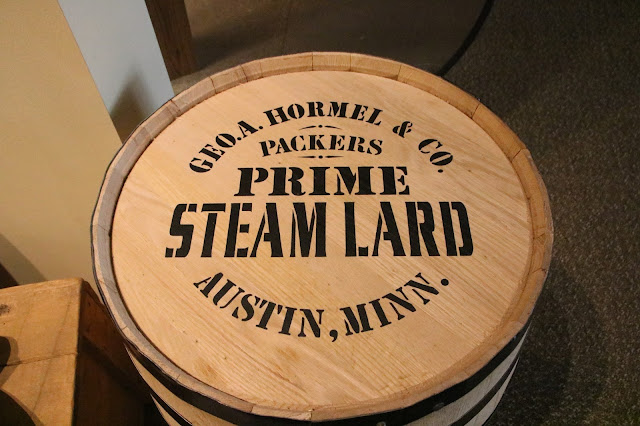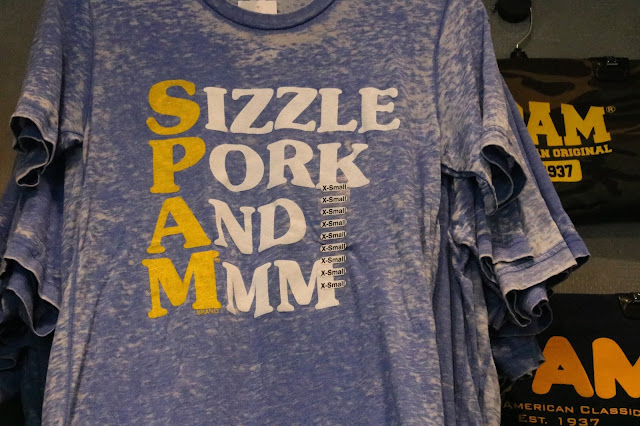September 2017 - Austin MN
The SPAM Museum was just part of a busy day in our cross country trip last September.
The Spam Museum is an admission-free museum in Austin, Minnesota dedicated to Spam, a brand of canned precooked meat products made by Hormel Foods Corporation. The museum tells the history of the Hormel company, the origin of Spam, and its place in world culture.
The Spam Museum originated in 1991 as the Hormel Foods First Century Museum, when Hormel opened a small storefront company museum in celebration of the company's 100 year anniversary. Located in Austin's Oak Park Mall, Hormel later re-branded it as the Spam Museum.

The museum re-opened on 22 April 2016 at its new location at 101 3rd Ave NE.
Pig Farmer tending his pigs outside the museum.
The location in downtown Austin is approximately 14,000 square feet in size and comprises seven main galleries. These include Can Central, "the heart of the museum".
Historical displays.
Spam (stylized SPAM) is a brand of canned cooked meat made by Hormel Foods Corporation. It was first introduced in 1937 and gained popularity worldwide after its use during World War II.The company was founded as George A. Hormel & Company in Austin by George A. Hormel in 1891. It changed its name to Hormel Foods in 1993. The company is listed on the Fortune 500.
George Hormel (born 1860 in Buffalo, New York) worked in a Chicago slaughterhouse before becoming a traveling wool and hide buyer. His travels took him to Austin and he decided to settle there, borrow $500, and open a meat business. Hormel handled the production side of the business and his partner, Albert Friedrich, handled the retail side. The two dissolved their partnership in 1891 so that Hormel could start a complete meat packing operation on his own. He opened George A. Hormel & Co. in the northeast part of Austin in an old creamery building on the Cedar River. To make ends meet in those early days, Hormel continued to trade in hides, eggs, wool, and poultry. Joining George in November 1891 was his youngest brother, Benjamin, age 14. By the end of 1891 Hormel employed six men and had slaughtered and sold 610 head of livestock. By 1893, the increased use of refrigerator cars and greater efficiency had forced smaller businesses to collapse. Two additional Hormel brothers, Herman and John, joined the business that same year, and together they processed 1,532 hogs. The remaining members of the Hormel family moved to Austin in 1895 and joined the growing business. George turned to full-time management in 1899, and focused on increasing production.
In 1921, when Jay Hormel returned from service in WWI, he uncovered that assistant controller Cy Thomson had embezzled $1,187,000 from the company over the previous ten years. The embezzlement scandal provided George Hormel with additional incentive to fortify his company. He did so by arranging for more reliable capital management, by dismissing unproductive employees, and by continuing to develop new products.
According to its label, Spam's basic ingredients are pork, with ham meat added, salt, water, modified potato starch as a binder, sugar, and sodium nitrite as a preservative. Natural gelatin is formed during cooking in its tins on the production line. Many have raised concerns over Spam's nutritional attributes, in large part due to its high content of fat, sodium, and preservatives.
When America entered World War II, SPAM® luncheon meat was called into action overseas. With Allied forces fighting to liberate Europe, Hormel provided 15 million cans of luncheon meat to troops every week. SPAM® luncheon meat became an essential item in soldiers’ diets, often serving as the last line of defense between battle-weary soldiers and starvation. Following the war, world leaders the likes of Dwight Eisenhower, Margaret Thatcher and Nikita Khrushchev all credited SPAM® luncheon meat for its role in the Allied victory.
In the United States in the aftermath of World War II, a troupe of former servicewomen was assembled by Hormel Foods to promote Spam from coast to coast. The group was known as the Hormel Girls and associated the food with being patriotic. In 1948, two years after its formation, the troupe had grown to 60 women with 16 forming an orchestra. The show went on to become a radio program where the main selling point was Spam. The Hormel Girls were disbanded in 1953.
Spam is especially popular in the state of Hawaii, where residents have the highest per capita consumption in the United States. Its perception there is very different from on the mainland.
A popular native sushi dish in Hawaii is Spam musubi, where cooked Spam is placed atop rice and wrapped in a band of nori, a form of onigiri. Varieties of Spam are found in Hawaii that are unavailable in other markets, including Honey Spam, Spam with Bacon, and Hot and Spicy Spam.
Hawaiian Burger King restaurants began serving Spam in 2007 to compete with the local McDonald's chains. In Hawaii, Spam is so popular that it is sometimes referred to as "The Hawaiian Steak".
In Guam, average per capita consumption is 16 tins per year. It is also found on McDonald's menus there.
Sandwich de Mezcla is a party staple in Puerto Rico containing Spam, Velveeta, and pimientos between two slices of sandwich bread.
After World War II, Newforge Foods, part of the Fitch Lovell group, was awarded the license to produce the product in the UK at its Gateacre factory, Liverpool, where it stayed until production switched to the Danish Crown Group (owners of the Tulip Food Company) in 1998.
The United Kingdom has adopted Spam into various recipes. For example, recipes include Spam Yorkshire Breakfast, Spamish Omelette, and Spam Hash.Spam can also be sliced, battered and deep-fried into Spam fritters.
,
Australia
In Okinawa, Japan, the product is added into onigiri alongside eggs and used as a staple ingredient in the traditional Okinawan dish chanpurū, and a Spam burger is sold by local fast food chain Jef. For the 70th anniversary of Spam in 2007, cans with special designs were sold in Japan due to its popularity, primarily in Okinawa. Following the March 2011 earthquake, Spam sales in Japan declined and Hormel shifted its focus to China although Hormel did pledge to donate $100,000 along with cans of Spam for relief efforts. In the summer of 2011, Burger King introduced its own version of a burger made of Spam, called 'BK Shot' Spam Burgers. These small burgers are filled with slices of the canned meat and were an attempt by Burger King to capitalize on Spam's popularity in Japan. In early 2014, Burger King also introduced the Spam and Cheese burger as a breakfast menu item.
In the Philippines, Spam is a popular food item and seen as a cultural symbol. It is prepared and used in a variety of ways, including being fried, served alongside condiments, or used in sandwiches. The canned meat's popularity transcends economic class, and Spam gift sets are even used as homecoming gifts. There are more than 9 different varieties of Spam currently available in the country and an estimated 1.25 million kilos of the meat is sold every year in the Philippines. During the rescue efforts after Typhoon Ondoy (Ketsana) in 2009, Hormel Foods donated over 30,000 pounds of Spam to the Philippine National Red Cross.
In later years, the surfeit of Spam in both North and South Korea during the Korean War led to the establishment of the Spam kimbap (rice and vegetable filled seaweed roll). Because of a scarcity of fish and other traditional kimbap products such as kimchi or fermented cabbage, Spam was added to a rice roll with kimchi and cucumber and wrapped in seaweed. Spam was also used by US soldiers in Korea as a means of trading for items, services or information around their bases.
Spam is also an original ingredient in budae jjigae ("army base stew"), a spicy stew with different types of preserved meat.
By the 1990s, Spam's perceived ubiquity led to its name being adopted for unsolicited electronic messages, especially spam email. Because of its use in a line of a song in Monty Python and the Holy Grail, the title of the musical version of the film became Spamalot.
Monty Python SPAM































































...in Hawaii, Spam is so popular that when it's on sale people buy it by
ReplyDelete...In Hawaii Spam is so popular that when it goes on sale people buy it by the case. Eggs, fried Spam and rice is a favorite breakfast. Thanks Jackie for sharing, enjoy your week.
ReplyDeleteThat is so cool. Thanks for sharing it with us. What an amazing place.
ReplyDeleteOne of the most interesting and fun posts I've seen in a really long time! Cracked me up to learn how many Spam cans long the Great Wall of China is! What a success story!
ReplyDeleteWell, I am amazed that such a museum exists. Spam would be more tolerable if it were not so salty.
ReplyDeleteThat looks like a big museum!
ReplyDelete